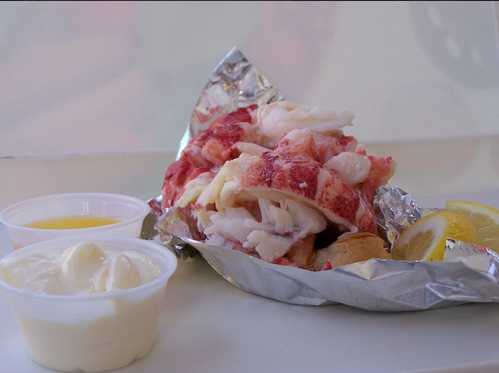Keywords: Lobsters
Item 80346
Sherman Jameson buying lobsters, Friendship, ca. 1910
Contributed by: Friendship Museum Date: circa 1910 Location: Friendship Media: Photographic print
Item 79584
Packing lobsters at Farrin's Wharf, South Bristol, ca. 1973
Contributed by: South Bristol Historical Society Date: circa 1973 Location: South Bristol Media: Postcard
Item 90188
Griffin property, Cliff Island Road, Portland, 1924
Owner in 1924: Stephen H. Griffin Use: Dwelling & Store
Exhibit
Jameson & Wotton Wharf, Friendship
Since 1897, the Jameson & Wotton Wharf in Friendship has been an important addition to the community on Muscongus Bay. The wharf, which is accessible at all tides, was a steamboat stop for many years, as well as important to the lobster business.
Exhibit
Summer Folk: The Postcard View
Vacationers, "rusticators," or tourists began flooding into Maine in the last quarter of the 19th century. Many arrived by train or steamer. Eventually, automobiles expanded and changed the tourist trade, and some vacationers bought their own "cottages."
Site Page
Scarborough: They Called It Owascoag - Catch of the Day: Clamming and Lobstering - Page 4 of 4
"… Point lobster pound dealers have been Googin’s Lobster Pound, Fogg’s Lobster Pound, Thurlow’s Shellfish (formerly Googin’s Lobster Pound), Pine…"
Site Page
Scarborough: They Called It Owascoag - Catch of the Day: Clamming and Lobstering - Page 3 of 4
"… Catch of the Day: Clamming and Lobstering Lobster Fishing The first recorded lobster catch was in 1605 when crew from the Archangel, captained by…"
Story
The tradition of lobstering
by Sadie Samuels
I learned to fish from my Dad and will lobster the rest of my life
Story
The best lobster roll in Maine!
by Debbie Gagnon
The history of Red's Eats and the recipe for our famous Lobster Rolls
Lesson Plan
Primary Sources: The Maine Shipyard
Grade Level: 9-12
Content Area: Social Studies
This lesson plan will give students a close-up look at historical operations behind Maine's famed shipbuilding and shipping industries. Students will examine primary sources including letters, bills of lading, images, and objects, and draw informed hypotheses about the evolution of the seafaring industry and its impact on Maine’s communities over time.















